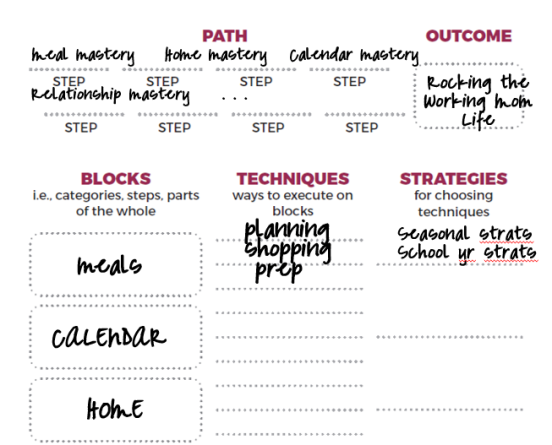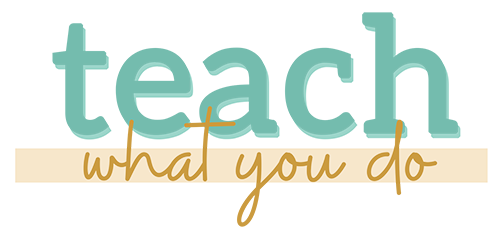
A “signature system” puts your expertise and best processes into a roadmap that your students can use to get to their goal.
I know that sounds like . . . an online course. And it could be an online course. Or even a series of online courses.
The thing is to actually have a “system” underlying those modules and lessons in your course.
And that system should be one that could only come from you. It's “signature,” and in it you’ve laid out a path that includes key building blocks, strategies, and techniques based upon your own practice and successes.
It’s a pathway that could only come from you.
Reasons to Create a Signature System for Your Course
When you codify the building blocks, strategies, techniques and sequences that you know get a client results, you're packaging your intellectual property, and the following happens:
- One-on-one client coaching becomes more efficient, and the results more predictable.
- You have a system you can leverage into a many-to-one course or program.
- When you make a course, the existence of the system's framework gives your overall course and your individual lessons a strong structure.
- You have more client success stories.
- Your authority builds.
- Marketing is easier because you can offer a one-of-a-kind solution.
The Pieces of a Signature System
At its highest level, your signature system provides a PATH with steps and SEQUENCING for your students to follow to get to their desired OUTCOME.
Along that path there will be CROSSROADS at which your students need to make decisions. Especially with creative goals, one student’s outcome is not going to look exactly like another student’s. Your system will provide the tools needed for your students to make good choices at those crossroads.
To support the CROSSROADS and PATH, your system will contain essential BUILDING BLOCKS. These blocks might well be in someone else's system on a similar topic, but what differentiates them will be the way you present STRATEGIES and TECHNIQUES for working with the building blocks in your system.
Understand Signature Systems Through Examples
There's no one way to put all these pieces of a signature system together. A creative course is going to have a different kind of framework than a technical course. A larger course will have a more complex system than a smaller one.
Here are a few examples to get you thinking about your own signature system.
a big signature system
The Teach What You Do eCourse Blueprint is my signature system for building a profitable online course. I start with the OUTCOME of a profitable online course.
Students are creating three BUILDING BLOCKS to get there:
- their course,
- their marketing systems, and
- their classroom.
Because students are moving these three threads (or building blocks) forward, the PATH I lay out needs to pay special attention to SEQUENCING.
The modules in my course provide the PATH. They go back and forth between these 3 BUILDING BLOCKS. Modules 1 and 2 are about both marketing and teaching. Module 3 concentrates on marketing. Module 4 concentrates on teaching. The 5th module is all about classroom setup, and the 6th module is mostly about marketing and a little bit about teaching.

That’s my step-by-step threaded approach to building a course, marketing systems, and classroom.
Within those modules are lessons that present TECHNIQUES along with STRATEGIES for choosing which techniques to use so that students can make their own choices when they reach CROSSROADS. For example, they'll need to decide what to teach, what formats to teach in, what kind of sales funnel to create, whether to include a launch event, or which classroom platform to use.
signature system spread across a portfolio of creative classes
When Dina Wakley came to my scrapbooking education site, Get It Scrapped, ready to teach online, she was already a popular art journaling teacher in live venues, and she knew her signature system.
To teach in an online venue, she broke her introductory system into three courses (two of which are still currently available at dinawakley.com and one of which is in her popular book on art journaling):
Art Journaling 101. Her first class taught the BLOCKS of art journaling with 4 lessons: 1. backgrounds, 2. collage, 3. text, and 4. top textures
Art Journaling 102. Her second class taught three types of TECHNIQUES: 1. Image Techniques, 2. Layer Techniques, and 3. Textures Techniques. The student can apply these techniques to the BLOCKS they learned about in the first class. The student could pick and choose which techniques to use.
Art Journaling 103. Her third class provided the STRATEGIES for making choices at CROSSROADS as students decided just how to combine BLOCKS and TECHNIQUES in their own creative ways. These strategies were design principles.

even with a simple course, a framework strengthens lesson structure
I teach a 5-lesson class at Get It Scrapped called “Visual Storytelling for Scrapbookers.” It teaches scrapbookers to evoke the aspects of a story one finds in written literature by using the visual tools of scrapbooking.
This simple framework is presented in Lesson 1. It starts with the BLOCKS that are the 5 elements of story on the left in the blue area: character, setting, plot, feelings, and universal themes. Over in the pink area are more BLOCKS but these correspond to parts of scrapbooking. Those four parts over in the pink are the basis for Lessons 2 through 4, in which TECHNIQUES and STRATEGIES are presented.
It's a simple system, but it gives the course order and it gives the students a framework for understanding the course content.

Get Started with Your Signature System
If you think about an online course this is how the pieces of your signature framework could map to the parts of a course:
- the BUILDING BLOCKS often equate to the MODULES of the course
- the TECHNIQUES and STRATEGIES are the meat of your LESSONS
- CROSSROADS decision-making capability will be the result of mastering this module and lesson content
- the PATH is the overall SEQUENCING of MODULES and LESSONS
Know, though, that your course and system may not match up exactly this way. It's your system, your topic, and your individual approach.
Worksheet for Mapping Your Signature System
Click here to download a worksheet and start mapping out your signature system. Remember: this isn't your course outline. Rather this is the framework of your knowledge.
Read on below for an example of how you might work with it.
example: use the worksheet to map a system you're living
Let’s talk about how to get started with your signature system if you’re teaching something that comes from they way you live, from beliefs or practices. Perhaps you run a successful MLM business selling clothing or oils. Maybe you’re great at throwing parties. Or maybe you’ve found a way to eat that keeps certain health problems in control.
Or how about this example: “How to Rock the Working Mom Life.”
The first thing to do is to step backward and figure out what you’re doing to rock this working mom life.
First identify BLOCKS in which you have practices. For example: 1. meals, 2. calendar, 3. home, 4. routines, 5. family.
Now you’ll think through your TECHNIQUES and STRATEGIES for rocking each of these areas (BLOCKS).
Consider the first: meals. What are your techniques and strategies for planning, shopping, prepping and even enjoying family meals that really make it all work. And what do you do when you’re at a CROSSROADS, like if things don’t go right? Those would be STRATEGIES. In the end, you could define a path of mastering each block to get to the outcome of “Rocking the Working Mom Life.”

A Signature System Stands Out in the Market and Ensures Student Success
Your signature system is your way of highlighting your “super powers” or your unique selling proposition. It's your path to making a course that both stands out in the market and that efficiently and successfully gets students to their desired outcome.

